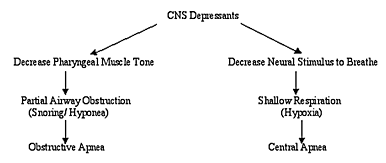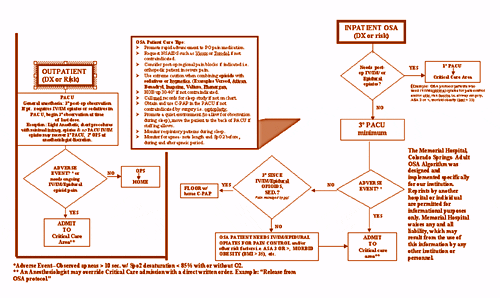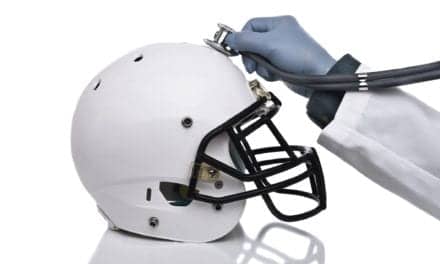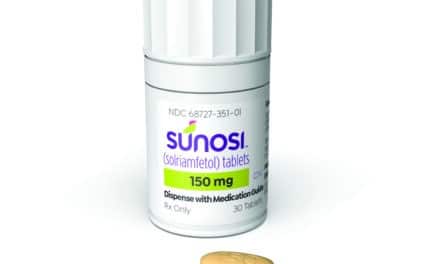Establishing an obstructive sleep apnea protocol in hospitals and educating health care teams at sleep centers regarding the risks associated with OSA and anesthesia can save lives.
On a daily basis, surgical patients are wheeled into operating rooms with unrecognized obstructive sleep apnea (OSA). Diagnosed OSA patients, as well as undiagnosed patients who present with classic signs and symptoms, are at risk for significant post-operative respiratory complications after receiving a general anesthetic and postoperative opiate analgesia.1-3 Yet health care providers frequently fail to screen for OSA, and when it is suspected or diagnosed, often fail to incorporate this data into the perioperative plan of care. Nationally, the accumulating cases of respiratory morbidity and mortality in perioperative patients4-6 served as the impetus to develop an adult peri-operative OSA protocol at Memorial Hospital, Colorado Springs, Colo.
Approximately 9% of women and 24% of men ages 30 to 60 have a apnea/hypopnea index of >5.7 Additionally, it has been estimated that 80% to 90% of patients with OSA are undiagnosed.8 Therefore, it became readily apparent that simply screening for patients with a diagnosis of OSA would be remiss, as the majority of patients at risk for OSA would be potentially neglected. Thus, a screening tool was developed based on a literature search and with help from the American Sleep Apnea Association (ASAA) denoting that a presumptive diagnosis of OSA can be made with a history of obesity, habitual snoring, frequent arousal during sleep, and daytime somnolence.9-11 The screening tool was placed on our preoperative health questionnaire and is completed by the patient. An element of our anesthesiologist perioperative medical examination includes reviewing the Sleep Screening Tool and performing a physical examination searching for stigmata of OSA, such as increased body mass index, hypertension, and signs and symptoms of a difficult airway. A history of habitual loud snoring and a positive response to any of the sleep screening questions accompanied by a positive anesthesiologist interview and examination qualify the patient for Memorial’s OSA protocol.
Basis for an OSA Protocol
The basis for the OSA protocol is centered largely on the effects of analgesia and anesthesia on patients with sleep apnea. It is well known that anesthetic, opiate, and sedative agents are central nervous system (CNS) depressants that increase the tendency for upper airway collapse (Figure 1). Additionally, CNS depressants alter the normal ventilatory response to hypercapnia and hypoxemia.2 Both CNS effects may be significantly worse in OSA patients as the decreased arousal response to breathe leads to prolonged apnea and the potential for respiratory and cardiovascular arrest.12,13 Compounding this problem is the technical difficulty of managing the airway, of bag and mask ventilation, and of endotracheal intubation, particularly in a crisis situation on a medical/surgical ward.
Figure 1. Effects of anesthesia on patients with sleep apnea.
We found our OSA protocol to be an effective risk management tool as evidenced by initial data collected during a trial run of the protocol. Eight of 31 patients experienced postoperative adverse events (AE), defined as apneic periods >10 seconds with O2 desaturation <85%. Of the eight, two patients were previously diagnosed with severe OSA, and the remaining six were screened for OSA and placed at high risk. The extended monitoring in the post anesthesia care unit (PACU) allowed for identification and treatment of obstructive airway AE that may have proved fatal in an unmonitored environment.
Once on the protocol, the plan of care for each patient is individualized based on the type of surgery and the pain management requirements for the patient. An algorithm (Figure 2) provides a guideline to determine the level of monitoring a patient should have in the postoperative period. In addition, an OSA global policy (see Table, page 49) was developed that delineates the standards of care for the OSA protocol patient. The key to providing the appropriate level of care is to ask whether the OSA patient will require ongoing postoperative opiates (intravenous, intramuscular, or epidural). If the answer is yes, then the OSA patient should be sent to a unit where close observation with continuous monitoring can be employed. Diagnosed patients who use continuous positive airway pressure (CPAP) are encouraged to bring in their own equipment to be used postoperatively. Patients who are placed on the protocol as “high risk” are given a letter with OSA information and recommendation for follow-up at a sleep disorder center, and the patients’ primary physician is faxed a copy as well.
Figure 2. Adult obstructive sleep apnea algorithm at Memorial Hospital,
Colorado Springs, Colo.
Currently, we place 50 to 60 patients per month on the protocol and approximately 50% require continuous monitoring in our intensive care unit (ICU). In general, the OSA patient on our protocol is not an “intensive” high acuity patient, so the use of the ICU 1:2 care is not necessary, nor cost-effective, if intermediate monitoring care is available; however, monitoring the patient on a pulse oximeter on the general medical/surgical ward is not likely to be satisfactory14 so our institution chose to open an intermediate care unit called the monitored surgical care area (MSCA). The MSCA will be fully operational by spring 2003, and is specifically designed to care for OSA protocol patients as well as other patient populations who require closer monitoring but not intensive care. The nurse patient ratio will be 1:3. Central monitoring consisting of continuous pulse oximetry and electrocardiography with a respiratory lead, and glass-enclosed rooms for close observation will be utilized.
Risk Management Protocol
While our screening tool may be too sensitive, we chose to initiate an OSA risk management protocol that provides safe, effective care in the appropriate setting, rather than risk patient safety. Several future studies are warranted to provide evidence-based guidelines regarding OSA and anesthesia. First, the design, implementation, and validation of a clinical OSA predictor tool are greatly needed (we hope to validate our screening tool in the near future). Second, the design and development of postoperative analgesia protocols that decrease the risk for postoperative apnea and respiratory compromise, and finally, studies on the efficacy of using CPAP on postoperative OSA patients.
As the prevalence of OSA increases, it is imperative that the health care teams at sleep centers educate their patients regarding the risks associated with OSA and anesthesia. For more information about sleep apnea and anesthesia, visit the Memorial Hospital Web site at [removed]http://www.memorialhospital.com/patient_care/surgery_faq.htm[/removed] and the ASAA Web site at [removed]http://www.sleepapnea.org/painmed.html[/removed].
Carla Lickteig, BSN, RN, CPAN, is PACU Care Manager, and Peter Grigg, MD, is a board-certified anesthesiologist and family practitioner, both at Memorial Hospital, Colorado Springs, Colo.
References
1. Riley RW, Powell WB, Guilleminault C, Pelayo R, Troell R, Li KK. Obstructive sleep apnea surgery: risk management and complications. Otalaryngol Head Neck Surg. 1997;117:648-652.
2. Cullen DJ. Obstructive sleep apnea and postoperative analgesia—a potentially dangerous combination. J Clin Anesth. 2001;13:83-85.
3. Boushra NN. Anaesthetic management of patients with sleep apnoea syndrome. Can J Anesth. 1996;43:599-616.
4. Ostermeier AM, Roizen MF, Hautkappe M, Klock PA, Klafa JM. Three sudden postoperative respiratory arrests associated with epidural opioids in patients with sleep apnea. Anesth Analg. 1997;85:452-460.
5. Lofsky A. Sleep apnea and narcotic postoperative pain medication: a morbidity and mortality risk. Anesthesia Patient Safety Foundation Newsletter. Summer 2002:24-25.
6. VanDercar DH, Martinez AP, Delisser EA. Sleep apnea syndromes: a potential contraindication for patient controlled analgesia. Anesthesiology. 1991;74:623-624.
7. Young T, Palta M, Demsey J, et al. The occurrence of sleep disordered breathing among middle aged adults. N Engl J Med. 1993;328:1230-1235.
8. Young T, Evan L, Finn L, et al. Estimation of the clinically diagnosed proportion of sleep apnea syndrome in middle age men and women. Sleep. 1997;20:705-706.
9. Benumof JL. Obstructive sleep apnea in the adult obese patient: implications for airway management. J Clin Anesth. 2001;13:144-156.
10. Ogan OU, Plevak DJ. Anesthesia safety is always an issue with obstructive sleep apnea. Anesthesia Patient Safety Foundation Newsletter. 1997;12:14-15.
11. American Sleep Apnea Association. What’s your snore score? Tired of the Sleepiness. Available at: http://www.sleepapnea.org. Accessed September 1, 2001.
12. Loadsman JA, Hillman JR. Anesthesia and sleep apnoea. Br J Anaesth. 2001;86:256-254.
13. Robinson RW, Zwillich CW, Bixler EO, et al. Effects of oral narcotics on sleep disordered breathing in healthy adults. Chest. 1987;91:197-203.
14. Benumof JL. Perioperative apnea diagnosis, management deemed critical. Anesthesiology News. April 2000.







